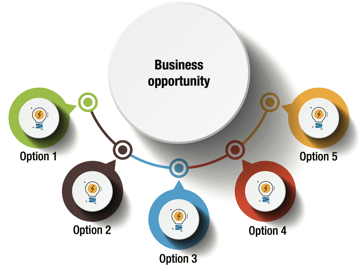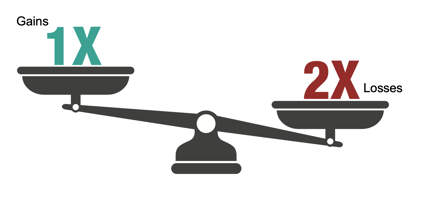Imagine if you could banish “no-decision” from your sales funnel. More deals that travel all the way to the win/loss finish line, less wasted sales time, more essential customer needs resolved, and a higher share of wallet. What’s standing in your way? Is it the wrong solution, an inadequate business case, inability to get budget, or something else? In our experience, the real problem boils down to one thing—the inability to create and build a business vision that propels your customer’s organization to embrace change.
Top-performing strategic account managers get this. They sell potential. They build a shared vision around the ability to address a compelling business need or market opportunity and build the scaffolding of commitment to make this vision a reality.
Top performers exhibit three essential characteristics, and they know how to deploy each trait based on the sales situation:
1. Divergent Thinking vs. Convergent Thinking
2. Learning vs. Teaching
3. Curiosity Quotient (CQ) vs. Intelligence Quotient (IQ)
Convergent versus Divergent Thinking
Convergent thinking is ideal when your customer has identified a need worth pursuing. Then, it becomes your job to move your solution down the sales stages, quantifying how your solution is superior to its alternatives in financial terms, aligning the buying center to get to "yes" and closing the deal at your target price. This requires a laser focus on addressing objections, knowing the decision-making path and being confident in the value of your solution.

Working sequentially through each stage in the sales cycle to close a deal at your price is an example of convergent thinking.
Divergent thinking, on the other hand, is better if you are convincing your customer that a thorny business problem is actually worth addressing or that a business opportunity is worth pursuing. This mode of thinking enables you to collaborate with your customer to frame a vision of the future they could achieve…with you as a trusted partner.
Divergent thinking explores possibilities, incorporates key trends, and connects the dots between your customer’s abilities and the future your customer wants. Building this shared vision takes time and requires active listening skills to follow the customer’s train of thought. However, the investment in time pays off when you create a shared vision that causes your customer to embrace change. In essence, divergent thinking is the antidote to “no decision.”

Exploring every facet of a problem to identify all contributing factors, areas impacted and means to address the issue is an example of divergent thinking.
Taking it one step further, top performers find ways to incorporate prospect theory to add additional “stickiness” to the business vision they just built with their customer. Why? Prospect Theory, or risk aversion, states a loss is “felt” twice as intensely as a gain. So, not achieving this vision will be viewed as a loss by your champion, who will want to work with you to make this vision a reality.
Ever wonder why car salespeople start with the luxury model? Because, as you eliminate features or move down to a lower model to fit your budget, you perceive each step as a loss and feel each step more intensely than if the salesperson had begun with the economy brand and upsold additional features. This is Prospect Theory at work.1

Learning, not teaching
Sellers are natural teachers. They are experts at the persuasive pitch, tuning the value message to each member of the buying center to move the deal forward. Your SAMs are probably most comfortable when explaining the key features of your offerings and how your solution stands out from the competition.
However, most buyers don’t look to vendors to educate them. In fact, 74% of B2B buyers do most of their research, online or by consulting internal experts, before engaging with vendors.1 Buyers’ perception of vendors’ ability to solve business issues is equally low. Only 23% of buyers rank vendors as a preferred resource for solving business problems.2
A much better approach is to ask questions to learn from your customer and practice an outside-in mindset.
Sellers are a whole lot less comfortable assuming the learner role and asking questions, especially open-ended questions, to learn from the customer. Sellers are supposed to be experts, right? Asking open-ended questions, especially about an area where the seller does not have a ready answer, can easily come across as being unknowledgeable, and no salesperson wants to "look dumb” in front of the customer.
In a review of 50,000 B2B sales calls, tech company Gong.io discovered that sellers who scattered questions throughout the call, to encourage conversation, and who listened more than talking, consistently secured more follow-on meetings and closed more deals than their colleagues.3
“The data affirms what great salespeople intuitively understand: When sellers ask questions, rather than just make their pitch, they close more deals.”
The trick is to ask questions to collaborate with your customer to explore a business challenge that you think they have. Begin with an insight or observation, then use open-ended questions to explore how this challenge impacts their business and what it would mean to their performance to solve this issue. Use divergent thinking to explore all contributing factors and business impact. Follow the customer’s train of thought, listen more than you talk and note those areas where your company might help. That is how you identify opportunities to explore further.
Buyers appreciate vendors who do their homework to understand their business and bring them insights. 90% of B2B buyers are willing to engage with vendors earlier in their buyer process, especially for complex business problems, that have cross-functional impact and are risky for the organization or their own careers.4 Remember Prospect Theory—risks, such as loss of career security, carry outsized impact.
Once you define, propose and close the deal on a solution that solves a core customer challenge, be sure that you define and put in place measurements that prove that you delivered on the promised business improvement. Make your buyer a champion by ensuring they communicate the financial improvement to their leaders. This assures that the next time your buyer identifies a business challenge or opportunity, you will be the first person they call.
Intelligence Quotient (IQ) versus Curiosity Quotient (CQ)
This last skill brings it all together.
Intelligence Quotient (IQ) is a necessary trait for any seller. Selling is complex, and sellers have to be able to master large amounts of information and think on their feet to navigate the complex buying centers and drive sales efficiency.
Curiosity Quotient (CQ) is the skill that drives sustainable sales excellence. Top performers need a high Curiosity Quotient to build an in-depth understanding of their customer’s business, learn from their customer, and collaborate with their customer to co-create opportunities to improve their business performance—now and in the future. In a survey of 3000 employees, across a broad range of industries, 92% credited people with a high level of curiosity for bringing new ideas into teams and driving organizational performance.5 Combining divergent thinking, questioning skills, and curiosity reduces “no decision” in your sales funnel and increases customer share of wallet. Together, these attributes drive profitable growth for both your salesforce and your customers.
References:
1 Kahneman and Tversky, 1979
2 Forrester Research, Myth-busting insight, 5/25/2015
3 Alison Wood Brooks and Leslie K. Brown, The Surprising Power of Questions, Harvard Business Review, May-June 2018
4 CSO Insights, 2019 Sales Performance Report
5 Francesca Gino, The Business Case for Curiosity, Harvard Business Review, September- October 2018

.jpg)